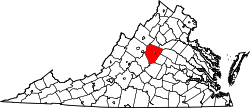Proffit, Virginia
| Proffit | |
|---|---|
| Unincorporated community | |
 Proffit  Proffit Location within the Commonwealth of Virginia | |
| Coordinates: 38°6′32″N 78°25′28″W / 38.10889°N 78.42444°WCoordinates: 38°6′32″N 78°25′28″W / 38.10889°N 78.42444°W | |
| Country | United States |
| State | Virginia |
| County | Albemarle |
| Time zone | Eastern (EST) (UTC-5) |
| • Summer (DST) | EDT (UTC-4) |
| GNIS feature ID | 1477646[1] |
Proffit is an unincorporated community in Albemarle County, Virginia.[1] There is no commercial activity, with only houses lining the road and a bridge under which Norfolk Southern's Piedmont Division, Washington District line runs.[2] It is recognized as a Virginia Landmark and the Proffit Historic District was listed on the National Register of Historic Places in 1999.[3]
Shortly after the Civil War the village was populated entirely by African Americans, when it was known as Egypt, and then as Bethel. It became known as Proffit when the railroad line went through, named for the man who bought the right of way for the line. As it became a minor commercial hub, the population gradually became more caucasian. By the late 1920s there were only 15-20 African American families remaining in Proffit.[4]
The historian, Claude Hall, author of Abel Parker Upshur, was born in Proffit, and procured three degrees from the University of Virginia.
References
- 1 2 "Proffit". Geographic Names Information System. United States Geological Survey. Retrieved August 12, 2013.
- ↑ Wilson, Paul (1999-01-02). "NS Piedmont Division, Washington District". Retrieved 2008-11-16.
- ↑ "Proffit Historic District Online Resource Archive". University of Virginia. 2000. Retrieved 2008-11-30.
Listed in the Virginia Landmark Register (1998) and the National Register of Historic Places (1999)...
- ↑ John Hammond Moore (1976). Albemarle: Jefferson's County, 1727-1976. Albemarle County Historical Society. p. 425.
Further reading
- The Proffit Historic District Online Resource Archive: A website that provides extensive documentation of the village's history, with a timeline, historical and contemporary photographs, census data, a virtual tour, and oral histories.
